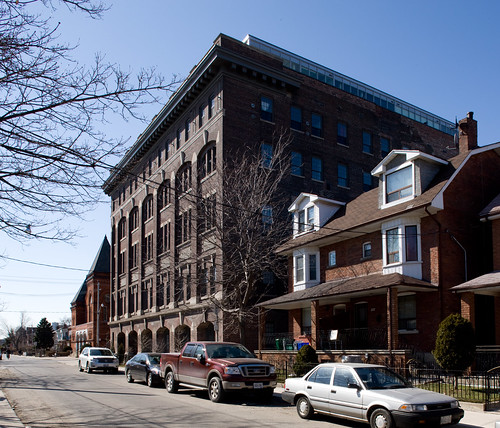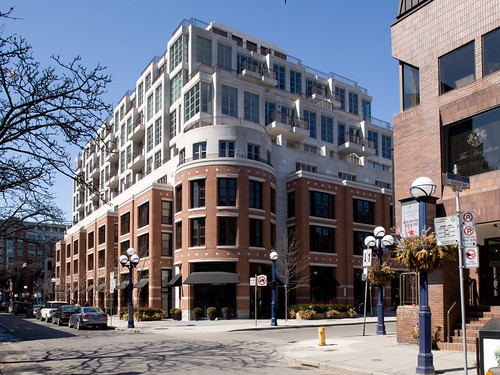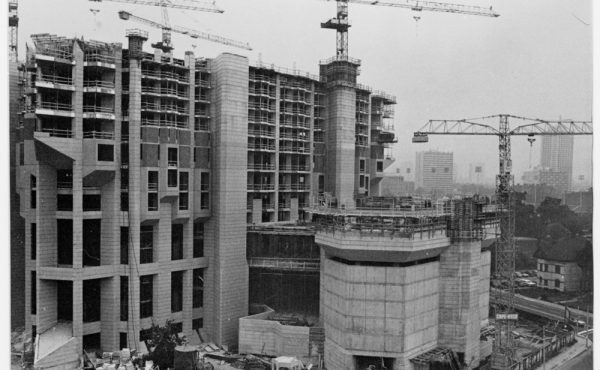
Photo of the Argyle Authentic Lofts, one of the winners at Wednesday night’s Pug Awards
Wednesday night I went to the fourth annual Pug Awards. Started in 2004 by Gary Berman, of Tricon Capital Group, and Anna Simone, of the design firm Cecconi Simone, the Pug Awards are a chance for people to vote for the best and worst developments over 50, 000 square feet built within the previous year in the former City of Toronto. There are two categories – residential, which had 18 nominated buildings, and commercial/institutional, which had 3 nominated buildings.
The ceremony was held in last year’s institutional winner, the Gardiner Museum, in the third floor gastro-spot operated by Toronto restaurateur Jamie Kennedy. The ceremony itself was very interesting: there was a packed house, great hors d’oeuvres, and an lively panel discussion with notables Bruce Kuwabara of KPMB Architects, City Councilor Kyle Rae, Gary Switzer of Great Gulf Homes, and Julie Di Lorenzo of Diamante Development Corporation that dealt with the state of design in the city of Toronto. But I left feeling that the awards program itself still has some room to grow. Although I support the premise of the Pug Awards (namely, to help inform the public about design excellence and contribute to a more livable city by improving the built environment through recognition of (or condemnation) of stand-out buildings), I think that the process of screening and selecting the winners (and losers) of the awards should be changed to better achieve those results.
Starting with the screening process, I am not entirely sure why only developments over 50, 000 square feet are entered into the vote. As we have seen in previous years, this is not necessarily a hard rule. The Gardiner Museum, for example, does not meet the square footage requirements but was entered because the Pug Awards Advisory Board reserves the right to enter any building that it deems noteworthy. Officially revising the rule to include different size-based categories would create a more interesting field of competitors. Architecture happens at many different scales, and does not need to be incredibly large in order to have a significant impact on the urban environment (think of a great community centre or park pavilion). By expanding the size limits, the Pugs might also avoid a list of nominees as homogeneous as the ones they had this year: a series of box-like towers that looked identical, contrasted by one or two strong, but still not truly remarkable, buildings.
The voting process also needs to be resolved. When I went on the Pug Awards website to check out the nominated buildings I was disappointed because all of the nominees only had three pictures to entice my vote, all of which were exterior shots. Judging a building from the outside only is a bit like judging a book by its cover, as buildings can offer far more on the inside than is evident from a front or side elevations. There were also no written descriptions to accompany any of the nominees (except for the name of the architect and the developer), and although there was a separate page outlining suggested criteria for voting to discourage superficial voting, including a short description of each building might help highlight some of the key features of the project that aren’t necessarily obvious by looking at the picture.
The last thing that I really think the Pug Awards need to do is expand to include the rest of the amalgamated city region, and even go beyond to the GTA. As the population in these areas is growing at much a faster rate than the former City of Toronto, there might be more going on in places like Brampton and Mississauga that needs a critical eye. I understand that this might already be in the works, I just hope it is up and ready for next year
The strongest part of the Pug Awards, and my favourite part of the night, was the announcement of the winners for the second annual Pug Ed student competition — giving Lisa Clemo of Jesse Ketchum Public School a $4000 educational bursary, and Mayuran Saravanapavanantham of Queen Alexandra Senior Public School a bursary of $2000. The students competed for the prize in a design competition/educational workshop held within those two schools, which was aimed at teaching young people about the built environment. This part gave me the strongest hope for the future of design excellence in the city, as it encourages young people to get involved early, and it would be particularly nice to see this part of the Pug Awards greatly expanded to other schools in the future.

In the main Pug Awards categories, the residential winner was the Argyle Authentic Lofts by Core Architects, and the commercial/institutional winner was the Hazelton Hotel (picture above) by Sol Wassermuhl, and Page + Steele Architects. For a break down of this years votes, or to learn more about this year’s awards, visit the Pug Awards on-line.
Photos by Joy von Tiedemann




6 comments
Is the Argyle one a totally new building? It seems too beautiful to not be old.
The Argyle is a retrofit of the Ideal Bread Factory, which I believe was built in 1919.
Which affirms Hague’s point; i.e. it may be a retrofit, but from the photographic evidence offered, voters were effectively asked to vote for an old building, with no evidence that anything “new” exists (cf. Lisa Rochon, who assailed the unseen “new” elements of the Argyle for their undemonstrative banality)
The end result could have been foretold, and it’d thrill (if with a lump in the throat, perhaps) many a heritage or anti-demolition advocate: given a choice, a “consensus” would sooner choose a good old building over *anything* new, whether it be ROM Crystal jagged abstraction or Hazelton namby-pamby traditionalism. And yes, said “consensus” even includes plenty of pro-moderns; only the kind of Dubai-gasm mentality which tips off Koolhaas territory into Howard Roark territory and has a Jane Jacobs dartboard on their office wall (or maybe, a few overly fussy “you’ve seen one Edwardian factory, you’ve seen them all” stylistic pedants, which might have been more common 40 years ago than today–even Eric “No Mean City” Arthur might have been among them) would offer a thumbs-down to the Ideal Bread Factory. As opposed to the Argyle Authentic Lofts…
I voted for these I while ago, but I seem to remember a couple of odd things about the process.
First, aren’t your choices restricted to “Love It” or “Hate It”? Depending on how people interpret this, the least-hated building could do better than one that thrills most people but turns off a few. Some in-the-middle choices seem important to let people distinguish between OK and great.
Second, the quality of the photos was uneven. I remember that one building looked terrible in its photos — based on those alone, I would have voted “Hate It” — but since it’s near me I’ve seen it in person and actually really love it. To avoid this, you either need a bunch of high-quality photos for every building, or to gently discourage people from voting for buildings they haven’t seen close up.
As for interior photos: aren’t the awards about the impact of the building on the city? For a public building, the interior seems like fair game, but for a condo it doesn’t really affect the neighbours if it’s ugly inside.
I disagree that a condo might will have limited impact on the city if the quality of the units is poor (cramped, poorly constructed) or the insides are ‘ugly’ – buildings like this will negatively affect the people living in them, and will experience a down turn far faster than a building much loved by its residence. Especially with buildings as large as the ones up for judgment in the Pug Awards, this can disenfranchise a large number of people and create sizable areas of decay in a neighbourhood.
In addition, some condos have spaces built into them that directly interact with the public realm – shops, restaurants, lobbies – and those spaces deserve to be explored and highlighted. Although some of the nominated buildings on the Pug Awards website have photos that show some of these spaces from the outside, with street level shots, I just think that by getting into a bit more detail, the Pug Awards would elevate the intended discourse on architecture, as a practice of shaping space, beyond the apparent discourse on how the building looks from the outside or from far away.
I think the Pug awards are unfortunate. First off, they started their life as the “Pugly awards” and in my mind have not lost their bias towards a critique of buildings, rather than praising them. The focus always should have been on buildings that people enjoy, and encouragement to appreciate our built environment rather than another opportunity to carp. I believe they’ve tried to fix this, but I remain suspicious of them.
Secondly, they encourage out-of-context (viewing on web) and overly simplistic (thumbs up; thumbs down) judgements of buildings. If the intent of the contest is to refine the city’s sense of its built environment and increase discussion, I find this an unfortunate approach.
Thirdly, and I understand this sets me up for criticism, I find that I am largely uninterested in a populist architecture contest. What am I supposed to make of the fact that people seem to prefer the Residences of College Park with its glued-on “ye olde” elements, to sleek and interesting Spire? I don’t find this fact says anything interesting about either of these buildings, or in fact, about the city, since there is clearly a huge market for dreck just about anywhere.